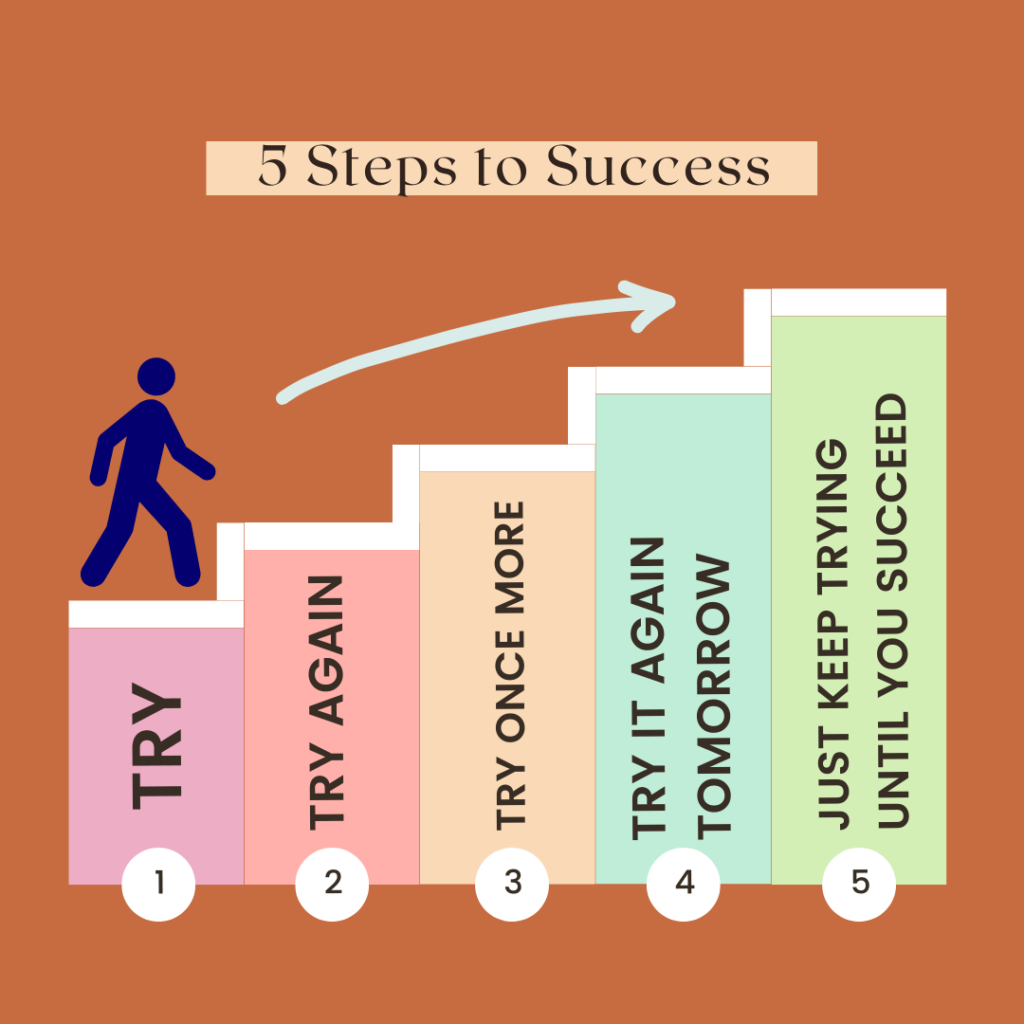5 Steps to Success

In today's fast-paced and competitive world, achieving success is a pursuit that captivates individuals across various domains. Whether it's excelling in a chosen career path, launching a thriving business, or mastering personal goals, the journey to success is often complex and multifaceted. While success is inherently subjective and unique to each individual, certain principles and strategies can serve as guiding lights on this path.
This comprehensive guide delves into a systematic approach comprising five pivotal steps that have proven instrumental in the success stories of numerous renowned figures and organizations. By unraveling these steps, we aim to provide you with actionable insights and a structured framework to navigate your own journey towards success.
1. Define Success: Setting Clear and Meaningful Goals

The first and arguably most critical step towards success is understanding and defining what success means to you personally. Success is not a one-size-fits-all concept; it is deeply rooted in your individual values, aspirations, and life experiences.
For some, success might be measured by financial milestones or professional accolades. It could mean achieving a leadership position in a corporate ladder, starting a profitable business, or making groundbreaking discoveries in scientific research. For others, success might be found in personal growth, building meaningful relationships, or contributing positively to society through community service or philanthropy.
Take time to introspect and reflect on your core desires and aspirations. Ask yourself: What truly matters to me? What brings me a sense of fulfillment and purpose? What are the milestones or achievements that would make me feel proud and content with my life's work?
Once you have identified your unique definition of success, it is essential to set clear and specific goals that align with this vision. Break down your long-term objectives into smaller, actionable targets. For instance, if your ultimate goal is to become a renowned author, your short-term goals might include completing a certain number of pages each day, attending writing workshops, or connecting with established authors for mentorship.
Setting clear goals provides a sense of direction and purpose. It helps you prioritize your efforts and make conscious choices that bring you closer to your desired outcomes. Moreover, it allows you to measure your progress, celebrate milestones, and make necessary adjustments along the way.
Case Study: The Entrepreneur’s Journey
Consider the example of Steve Jobs, the co-founder of Apple Inc. Jobs’ initial goal was not merely to create a successful business but to revolutionize the way people interacted with technology. He envisioned a world where computers were not just tools for professionals but also accessible and intuitive devices for everyday use. This clear vision guided his every decision, from product design to marketing strategies, ultimately leading to the creation of iconic products like the Macintosh, iPhone, and iPad.
2. Develop a Growth Mindset: Embracing Challenges

Success often emerges from a willingness to embrace challenges and view them as opportunities for growth and learning. Adopting a growth mindset, as popularized by psychologist Carol Dweck, is pivotal in this regard.
Individuals with a growth mindset believe that their abilities and intelligence can be developed and enhanced through dedication, hard work, and learning from failures. They see setbacks and mistakes not as barriers but as valuable lessons that pave the way for improvement. In contrast, a fixed mindset limits individuals by making them believe that their abilities are innate and unchangeable, often leading to a fear of failure and a reluctance to step out of their comfort zones.
Developing a growth mindset involves reframing how you perceive challenges and setbacks. Instead of viewing them as obstacles, see them as opportunities to learn, adapt, and innovate. Embrace failure as a necessary step on the path to success. Remember, some of the most successful individuals and businesses have encountered significant failures along their journeys, but it is their resilience and willingness to learn from these experiences that set them apart.
Foster a culture of continuous learning and improvement in your personal and professional life. Seek out new experiences, embrace diverse perspectives, and remain open to feedback and constructive criticism. By adopting a growth mindset, you empower yourself to overcome obstacles, adapt to changing circumstances, and ultimately, thrive in the face of challenges.
The Power of Resilience: A Real-World Example
Consider the story of J.K. Rowling, the author of the immensely popular Harry Potter series. Before achieving international success, Rowling faced numerous rejections from publishers and struggled financially. However, she persisted, refining her writing and submitting her manuscript to various publishers until she finally found success. Her resilience and unwavering belief in her work are a testament to the power of a growth mindset. Today, her books have sold over 500 million copies, and she is one of the most successful authors of all time.
3. Create a Strategic Plan: Mapping Your Journey
With a clear definition of success and a growth-oriented mindset, the next step is to develop a comprehensive strategic plan to guide your journey. A well-thought-out plan provides structure, helps allocate resources efficiently, and ensures that your efforts are focused and aligned with your goals.
Begin by breaking down your long-term goals into a series of shorter-term objectives. Each objective should be Specific, Measurable, Attainable, Relevant, and Time-bound (SMART). For instance, if your goal is to launch a successful startup, your short-term objectives might include developing a detailed business plan, securing funding, assembling a talented team, and launching a minimum viable product (MVP) within a defined timeframe.
Create a timeline for each objective, outlining the specific tasks, resources, and milestones required to achieve them. Be realistic in your planning, considering factors such as your available time, financial resources, and personal or professional commitments. Regularly review and update your plan to ensure it remains aligned with your evolving goals and circumstances.
Incorporating flexibility into your plan is crucial. As you progress, you may encounter unexpected challenges or opportunities that require adjustments to your strategy. Embrace these changes as opportunities to refine and optimize your approach, ensuring your plan remains responsive to the dynamic nature of your journey.
Strategic Planning in Action: A Case Study
Take the example of Elon Musk, the visionary behind Tesla, SpaceX, and numerous other innovative ventures. Musk’s success can be attributed, in part, to his meticulous strategic planning. Before launching Tesla, he thoroughly researched the market, identified gaps in existing electric vehicle technologies, and developed a clear vision for the company’s future. He then created a detailed plan outlining the steps required to bring his vision to life, from designing cutting-edge electric vehicles to establishing a robust charging infrastructure network.
4. Take Action: Execution and Persistence
Having defined your goals, adopted a growth mindset, and crafted a strategic plan, the next critical step is to take decisive action. It is one thing to have a well-thought-out plan, but it is through execution that true progress is made.
Start by prioritizing your tasks and objectives based on their urgency and importance. Focus on the actions that will have the most significant impact on your goals and allocate your time and resources accordingly. Break down complex tasks into smaller, manageable steps to make them less overwhelming and more achievable.
Maintain a disciplined approach to your work, setting aside dedicated time for focused execution. Eliminate distractions and create an environment conducive to productivity. Regularly review your progress and celebrate your achievements, no matter how small. This not only motivates you to continue but also helps you identify areas where adjustments or refinements may be needed.
Remember, success is rarely achieved overnight. It requires persistence, consistency, and the ability to endure setbacks and challenges. Embrace a long-term perspective and maintain a resilient attitude. View setbacks as temporary hurdles rather than permanent roadblocks. Learn from your mistakes, adapt your strategies, and keep moving forward.
The Power of Action: A Successful Business Example
Consider the story of Richard Branson, the founder of the Virgin Group. Branson’s success can be attributed to his relentless pursuit of opportunities and his willingness to take calculated risks. From starting a student magazine at a young age to launching Virgin Records and Virgin Atlantic Airways, Branson has consistently taken action to bring his ideas to life. His ability to execute his vision, coupled with a strong work ethic and a customer-centric approach, has made the Virgin brand a global success.
5. Learn and Adapt: Continuous Improvement

Success is not a static destination but an ongoing journey of learning, growth, and adaptation. Even after achieving significant milestones, successful individuals and organizations recognize the importance of continuous improvement to maintain their edge and stay relevant.
Regularly evaluate your progress and performance against your defined goals. Identify areas where you have excelled and areas that require further attention or refinement. Seek feedback from trusted mentors, colleagues, or clients to gain valuable insights into your strengths and weaknesses. Use this information to refine your strategies, enhance your skills, and optimize your approach.
Stay abreast of industry trends, technological advancements, and changing consumer preferences. Attend conferences, workshops, and networking events to connect with like-minded individuals and stay inspired. Read widely, both within and outside your field, to expand your knowledge and gain fresh perspectives. Embrace a culture of learning and continuous self-improvement to stay ahead of the curve and maintain your competitive advantage.
Furthermore, remain open to new ideas and innovative approaches. While your initial plan may have been well-crafted, the dynamic nature of the world often necessitates adaptability. Be willing to pivot your strategies, embrace new technologies, and adapt to changing market conditions. This flexibility will ensure that you remain relevant and can seize emerging opportunities.
Embracing Change: A Successful Adaptation Story
Consider the evolution of Nike, the world-renowned sportswear brand. In the early 2000s, Nike recognized the growing importance of sustainability and ethical manufacturing practices. Rather than resist this trend, Nike embraced it, making significant changes to its supply chain and product design. This adaptation not only aligned the company with consumer values but also positioned Nike as a leader in sustainable fashion, demonstrating the power of continuous improvement and adaptation.
Conclusion: A Journey of Self-Discovery and Growth
The path to success is a deeply personal journey of self-discovery, growth, and resilience. While the five steps outlined in this guide provide a structured framework, it is essential to remember that your unique journey will unfold in ways that are uniquely yours.
Define your success, embrace challenges, plan strategically, take action with persistence, and continuously learn and adapt. By following these steps and maintaining a growth-oriented mindset, you empower yourself to overcome obstacles, seize opportunities, and ultimately achieve success on your own terms.
Remember, success is not solely about the destination but also about the enriching experiences and valuable lessons learned along the way. Embrace the challenges, celebrate the victories, and keep moving forward with unwavering determination. Your journey to success is a testament to your resilience, creativity, and ability to make a meaningful impact in the world.
How long does it typically take to achieve success following these steps?
+The timeline for achieving success varies greatly depending on individual circumstances, the nature of your goals, and the level of dedication and effort you put into your pursuit. Some goals may be realized within a matter of months, while others may take years of consistent effort and refinement. It’s important to maintain a long-term perspective and understand that success is often a marathon, not a sprint.
Can these steps be applied to any area of life, or are they limited to professional pursuits?
+Absolutely! While these steps are commonly associated with professional success, they can be adapted and applied to various areas of life. Whether you’re striving for personal growth, improving your health and well-being, pursuing artistic endeavors, or strengthening relationships, the principles of defining goals, adopting a growth mindset, strategic planning, taking action, and continuous improvement remain relevant and can significantly enhance your chances of success.
How can I stay motivated and maintain focus during challenging times?
+Staying motivated and focused during challenging times requires a combination of self-awareness, resilience, and a clear sense of purpose. First, understand your personal motivations and the underlying reasons why you embarked on your journey. Regularly remind yourself of your “why” to reignite your passion and determination. Additionally, cultivate a growth mindset, embracing challenges as opportunities for growth and learning. Surround yourself with a supportive network of peers, mentors, or like-minded individuals who can provide encouragement and accountability. Finally, practice self-care and ensure you are taking care of your physical and mental well-being, as this will sustain your energy and resilience during difficult periods.



